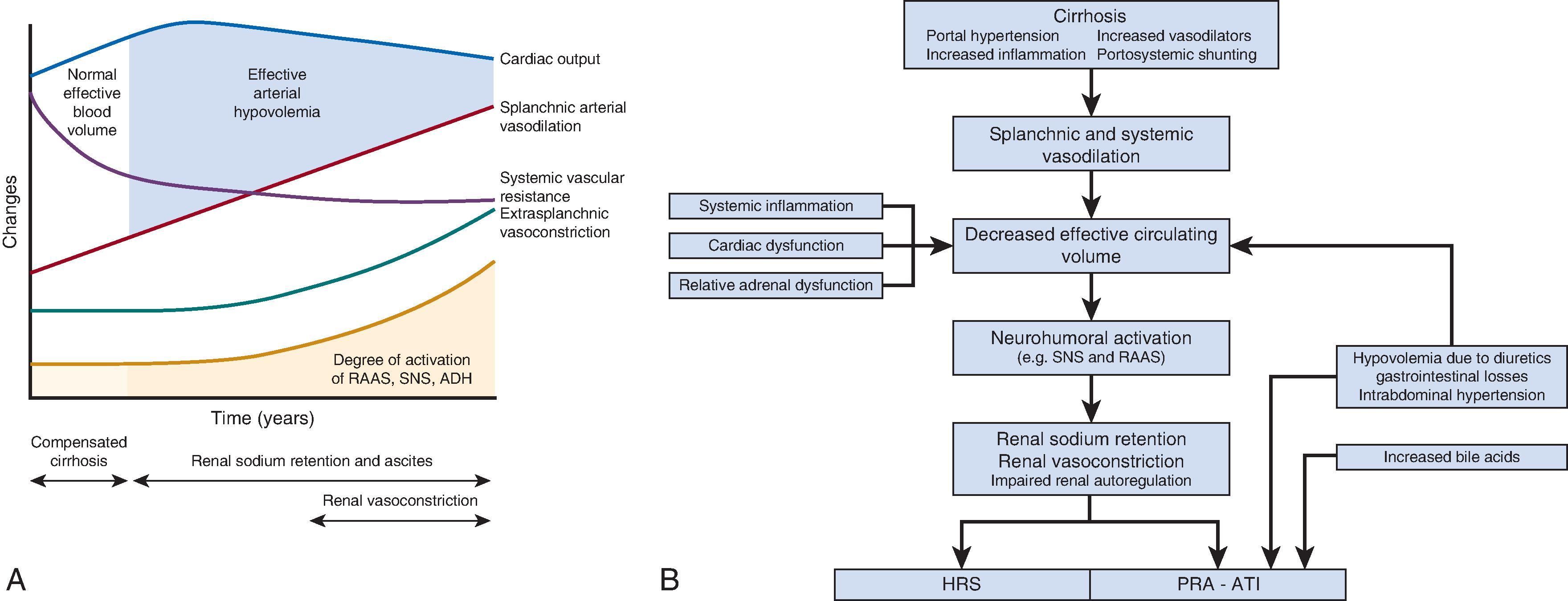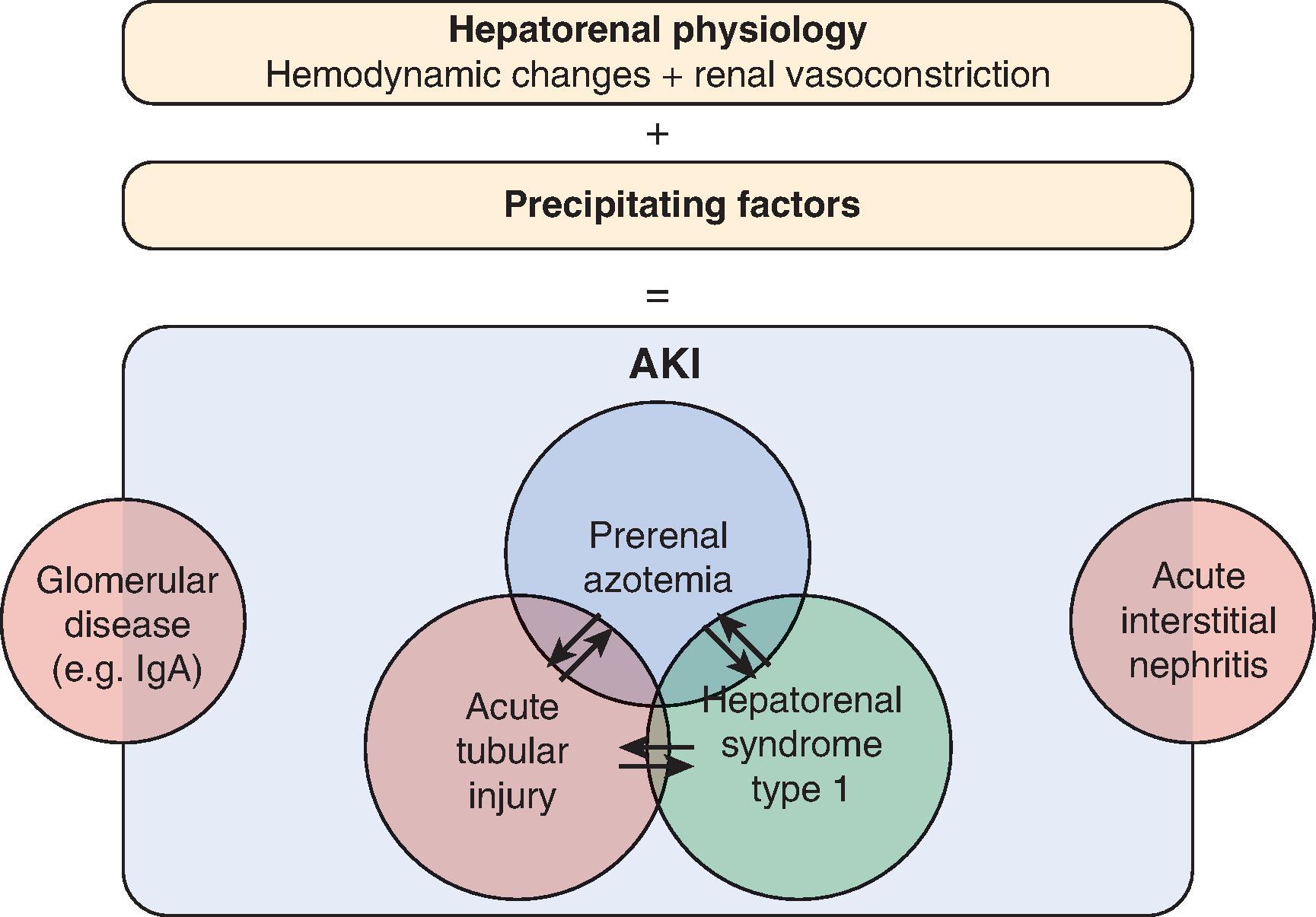Physical Address
304 North Cardinal St.
Dorchester Center, MA 02124
Systemic homeostasis is normally maintained by a neurohumoral communication-feedback loop between major organs. Any dysregulation of this organ cross talk can contribute to organ dysfunction during times of illness; that is, injury to one organ can have direct or indirect (via medical therapies) deleterious repercussions on the other. There are few circumstances in which this link is as extensive as it is between the kidneys and liver ( Table 30.1 ). These organs can be concurrently affected through two main mechanisms. First, systemic factors, including toxins, genetic ailments, or infections, can concomitantly affect the liver and the kidneys, such that kidney dysfunction is secondary to the systemic disorder and not due to liver disease. Second, the kidney dysfunction may be driven by the presence of liver disease/cirrhosis, reflecting an abnormal neurohumoral feedback loop causing systemic vasodilation with renal vasoconstriction in individuals with advancing cirrhosis. This decrease in effective arterial blood volume is often exacerbated by volume depletion due to gastrointestinal bleeding, therapies that promote gastrointestinal or urinary volume losses (e.g., lactulose and diuretics), and large volume paracentesis (LVP). Moreover, these individuals are often exposed to nephrotoxic antibiotics to treat infections, including spontaneous bacterial peritonitis (SBP).
| Diseases Primarily Affecting the Liver | |||
| Cirrhosis | AKI-non-HRS |
|
|
| AKI-HRS |
|
||
| CKD-HRS |
|
||
| Cirrhotic glomerulopathy (e.g., IgA deposition) | |||
| Primary sclerosing cholangitis | Tubulointerstitial nephritis, hyperoxaluria/nephrolithiasis, RTA | ||
| Primary biliary cirrhosis | Tubulointerstitial nephritis, membranous glomerulonephritis, RTA | ||
| Autoimmune hepatitis | Immune-mediated and membranous glomerulonephritis | ||
| NASH | Diabetic nephropathy | ||
| Infectious Diseases | |||
| Hepatitis B | Membranous glomerulonephritis, membranoproliferative glomerulonephritis, polyarteritis nodosa | ||
| Hepatitis C | Membranoproliferative Glomerulonephritis, cryoglobulinemic glomerulonephritis, membranous glomerulonephritis | ||
| Schistosomiasis | Immune-mediated glomerulonephritis, AA amyloidosis | ||
| Leishmaniasis | Interstitial nephritis | ||
| Systemic Diseases Affecting Both Organs | |||
| Hemodynamic shock | Hypovolemic, ischemic, or septic AKI | ||
| Amyloidosis | Amyloidosis | ||
| Sarcoidosis | Granulomatous tubulointerstitial nephritis, nephrolithiasis, RTA | ||
| Sjogren syndrome | Tubulointerstitial nephritis, RTA | ||
| Congenital and Hereditary | |||
| Polycystic liver disease | Autosomal dominant polycystic kidney disease | ||
| Congenital hepatic fibrosis | Autosomal recessive polycystic kidney disease, nephronophthisis | ||
| Arteriohepatic dysplasia | Renal dysplasia, tubulointerstitial nephritis, | ||
| α1-antitrypsin deficiency | Membranoproliferative glomerulonephritis, anti-GBM disease | ||
| Pregnancy-Associated Diseases | |||
| Eclampsia | |||
| HELLP syndrome | |||
| Fatty liver of pregnancy | Tubulointerstitial nephritis | ||
| Drugs and Toxins (Other Than Alcohol) That Can Cause Combined Liver and Kidney Injury | |||
| Acetaminophen toxicity | Antineoplastic agents | Elemental phosphorus | |
| Reye syndrome | Methoxyflurane | Copper | |
| Tetracyclines | Phenytoin | Amatoxins | |
| Allopurinol | Carbon tetrachloride | Arsenic | |
| Methotrexate | Trichloroethylene | Chromium | |
| Rifampin | Chloroform | Barium | |
Along with the heightened risk of common forms of acute kidney injury (AKI), cirrhosis is also linked to progressive kidney dysfunction that culminates in a specific form of prerenal AKI that does not respond to volume expansion, the hepatorenal syndrome (HRS). An association between the presence of ascites and kidney failure was first described in 1863. Later studies found that this form of severe kidney failure was associated with little to no histological abnormalities, suggesting HRS is a functional disorder and may be potentially reversible. Subsequent studies demonstrated that the marked alterations in kidney perfusion and function can be reversed by transplanting the kidneys into non-cirrhotic patients or curing the liver disease via liver transplantation, further supporting the notion that HRS is reversible. Two clinical patterns of HRS have been described: an acute form (type 1 HRS, HRS-1, or AKI-HRS), characterized by rapid decline in kidney function over less than 2 weeks, and a chronic form (type 2 HRS, HRS-2, or CKD-HRS), with a more insidious onset, progressing slowly over weeks to months.
Despite the potential reversibility, HRS is associated with a high mortality rate. Even after resolution of the AKI episode, cirrhotic patients who developed AKI have worse survival compared to those who did not. Among HRS-1 patients requiring hospitalization, mortality approaches 80% in 3 months if untreated, three times higher than seen in individuals with cirrhosis without HRS. While the introduction of vasoconstrictor therapy for HRS treatment and better patient care have improved survival, kidney dysfunction cannot be reversed in many patients, with important prognostic and therapeutic implications. We review the mechanisms that may contribute to AKI in patients with liver disease, and then use these concepts to provide an update to the diagnosis, prevention, and treatment of AKI and HRS.
Several mechanisms interact in cirrhosis to increase the risk of AKI ( Fig. 30.1 ). The presence of hepatorenal physiology, defined by the combined effects of cirrhosis-induced circulatory dysfunction and maladaptive kidney perfusion, renders the kidney very susceptible to dysfunction and injury. Moreover, increased exposure to non-hemodynamic factors and other nephrotoxic elements, such as hypovolemia, infections, endogenous toxins, and nephrotoxic medications, not only further increases susceptibility to AKI, but can also directly cause AKI through more common etiologies including perfusion-related AKI and acute tubular injury (ATI). Although perfusion-related AKI and ATI are more common than HRS-1 and differ in their pathogenic mechanisms, AKI in these patients is likely multifactorial, with a considerable overlap in mechanism ( Fig. 30.2 ). Perhaps this explains why fewer than 40% of patients with HRS respond to appropriate vasoconstrictor therapy, and that responsiveness to therapy and recovery of kidney function decreases with the duration of AKI/HRS. Thus, it is imperative that clinicians understand the hemodynamic and non-hemodynamic mechanisms underlying AKI and HRS in each individual patient in order to develop an optimal diagnostic and therapeutic strategy.


Arterial vasodilatation, the main circulatory derangement leading to hepatorenal physiology, is generated by the following cascade of events. First, damage to the hepatic parenchyma results in increased resistance to blood flow through the liver, causing portal hypertension, portosystemic shunting, and increased local production of various vasodilators, particularly nitric oxide (NO). Subsequently, these vasodilators spill over into the splanchnic and systemic circulation, causing arterial vasodilation and decreased effective arterial blood volume. This arterial underfilling triggers activation of the sympathetic nervous system (SNS) and the renin–angiotensin-aldosterone system (RAAS) in an attempt to restore effective circulatory volume and maintain blood pressure. In the pre-ascites phase and in the setting of diuretic-responsive ascites, compensatory increases in heart rate, sodium retention, and cardiac output caused by activation of these systems are sufficient to normalize effective circulating volume and blood pressure. However, elevated levels of angiotensin II, norepinephrine, and other vasoconstrictors, resulting from SNS and RAS activation, provoke vasoconstriction of localized vascular beds, including the liver, brain, muscle, and the kidney. With worsening severity of underlying liver disease, splanchnic and systemic arterial vasodilation can overwhelm the compensatory capacity, leading to a reduction in blood pressure, potentially compromising tissue and organ perfusion. Indeed, in late-stage cirrhosis (diuretic-resistant ascites and beyond), these compensatory mechanisms fail to maintain an effective circulating volume, and renal vasoconstriction worsens, facilitating the development of HRS.
Activation of the SNS and RAAS is associated with increased angiotensin II, norepinephrine, and other vasoconstrictors (e.g., endothelin, thromboxane, isoprostanes, adenosine), which decrease renal blood flow and shunt perfusion away from the cortex toward the salt-avid juxtamedullary nephrons. Moreover, there is a rightward shift of the autoregulatory curve (indicating lower renal blood flow for any given renal perfusion pressure) and abnormal vascular reactivity; the preglomerular arterioles become less responsive to vasodilators and more responsive to vasoconstrictors. These changes restrict the kidney’s capacity to adapt to reductions in perfusion pressure and increase its dependency on renal vasodilators to maintain perfusion. Indeed, there is a compensatory increase in intrarenal vasodilating peptides (e.g., prostaglandin I2 and E2), which may explain the reason why cirrhotics are more susceptible to NSAID-induced AKI.
In earlier stages of cirrhosis, the effective circulatory volume and blood pressure are maintained by increased cardiac output. However, as the disease progresses, cardiac output falls due to blunted cardiac responsiveness, impaired diastolic relaxation, and conductance abnormalities. The etiology of cirrhotic cardiomyopathy is unclear but may be related to sympathetic myocardial toxicity (a variant of catecholamine-cardiomyopathy) or increased cytokine production during cirrhosis. Regardless of cause, there is increasing evidence that cirrhotic cardiomyopathy is complicit in the development of HRS; it is associated with decreased renal blood flow and GFR, and a higher probability of developing HRS-1. Cardiac dysfunction might also explain the greater risk of HRS in patients receiving nonselective β-blockers to treat portal hypertension. On the other hand, reports of improvement in cardiac and kidney function after placing a transjugular intrahepatic portosystemic shunt suggests cirrhotic cardiomyopathy may be reversible. Because of the increasing evidence of interplay between the liver, heart, and kidney during cirrhosis, the term hepatocardiorenal syndrome has been proposed.
Markers of inflammation such as TNF-α, interleukin-6 (IL-6), and C-reactive protein (CRP) increase in parallel with the progression of liver disease and portal hypertension, even in the absence of clinical evidence of active infection. This inflammation is primarily initiated by translocation of bacteria and/or pathogen-associated molecular patterns from the intestinal lumen and from damage-associated molecular patterns from the injured liver. The subsequent activation of innate host immunity leads to the release of proinflammatory cytokines and oxidative stress, which impair cardiovascular function and exacerbate endothelial dysfunction, thus damaging the function of several organs and directly promoting renal tubular injury. Indeed, elevation of proinflammatory markers can occur with any infection, especially SBP, leading to further deterioration of the circulatory dysfunction and precipitating HRS. This progression is now recognized to be part of a complex syndrome, acute on chronic liver failure (ACLF), characterized by multiorgan failure. Its importance in the pathogenesis of AKI and HRS is further supported by studies showing that gut decontamination with rifaximin improves systemic hemodynamics and kidney function in cirrhotic patients with ascites and that norfloxacin reduces the risk of HRS, independent of SBP prevention.
The main determinant of kidney perfusion is mean arterial pressure (MAP). However, abdominal organ venous outflow pressure (AVOP) can also impact organ perfusion, particularly when MAP is low. AVOP is best represented as the greater of central venous pressure and intraabdominal pressure (IAP). Under normal conditions, IAP ranges from 4–7 mm Hg and has little impact on AVOP; however, if IAP rises, venous pressure in the abdomen increases, resulting in venous congestion and end-organ edema and dysfunction as well as a decrease in abdominal perfusion pressure (the difference between MAP and IAP). Tense ascites increases IAP causing IAH and, thus, may impair kidney perfusion. Accordingly, there are reports of AKI resolution following large volume paracentesis (LVP) to reduce intraabdominal pressure. However, LVP can also worsen circulatory dysfunction and precipitate AKI, especially when intravenous albumin is not given. Thus, when and how to use IAP measurements and reactive LVP remain to be determined.
Become a Clinical Tree membership for Full access and enjoy Unlimited articles
If you are a member. Log in here